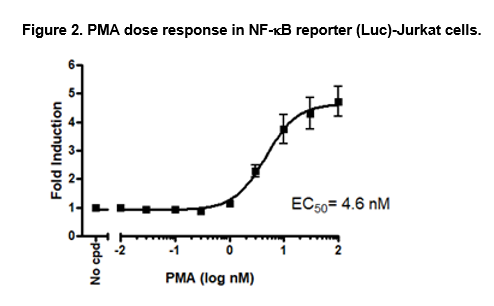60651
NF-κB Luciferase Reporter Jurkat Cell Line
BPS Bioscience
DESCRIPTION
NF-κB luciferase reporter construct is stably integrated into the genome of Jurkat T- cells. The firefly luciferase gene is controlled by 4 copies of NF-kB response element located upstream of the TATA promoter. Following activation by stimulants, endogenous NF-κB transcription factors bind to the DNA response elements to induce transcription of the luciferase gene.
DETAILS
- Notes: License Disclosure: Purchase of this cell line grants you with a 10-year license to use this cell line in your immediate laboratory, for research use only. This license does not permit you to share, distribute, sell, sublicense, or otherwise make the cell line available for use to other laboratories, departments, research institutions, hospitals, universities, or biotech companies. The license does not permit use of this cell line in humans or for therapeutic or drug use. The license does not permit modification of the cell line in any way. Inappropriate use or distribution of this cell line will result in revocation of the license and result in an immediate cease of sales and distribution of BPS products to your laboratory. BPS does not warrant the suitability of the cell line for any particular use, and does not accept any liability in connection with the handling or use of the cell line. Modifications of this cell line, transfer to another facility, or commercial use of the cells may require a separate license and additional fees; contact sales@bpsbioscience.com for details. Publications using this cell line should reference BPS Bioscience, Inc., San Diego.
- Format: Each vial contains ~2 x 10^6 cells in 1mL of 10% DMSO in FBS.
- Shiptemp: -80°C (dry ice)
- Synonyms: NF-κB cell line, NFkappaB cell line, luciferase reporter, NF-kB cell line, NFkB cell line
- Warnings: Avoid freeze/thaw cycles.
- Category: Immunotherapy/Cell Line
- References: 1. Borner C and Kraus J (2013) Inhibition of NF-kB by Opioids in T cells. J Immunology. 191. 2. Mori N. et.al. (2002) Bay 11-7082 inhibits transcription factor NF-kB and induces apoptosis of HTLV-1- infected T cell lines and primary adult T-cell leukemia cells. Blood. 100: 1828-1834 3. Takada Y, Kobayashi Y, Aggarawal BB (2005) Evodiamine abolishes constitutive and inducible NF-kappaB activation by inhibiting IkappaBalpha kinase activation, thereby suppressing NF-kappaB-regulated antiapoptotic and metastatic gene expression, up-regulating apopotiss and inhibiting invasion. J Biol Chem. 280: 17203
- Description: NF-κB luciferase reporter construct is stably integrated into the genome of Jurkat T- cells. The firefly luciferase gene is controlled by 4 copies of NF-kB response element located upstream of the TATA promoter. Following activation by stimulants, endogenous NF-κB transcription factors bind to the DNA response elements to induce transcription of the luciferase gene.
- Unspsc Code: 41106514
- Unspsc Name: Stable mammalian cell lines
- Applications: The NF-κB-luciferase/Jurkat cell line is suitable for monitoring the activity of NF-kB signaling in response to stimulant, and establishing cell-based screens for inhibitors that target specific NF-κB stimulating molecules.
- Host Species: human
- Product Type: Cell Line
- Host Cell Line: Jurkat
- Biosafety Level: BSL-1
- Related Products: 79530, 60690, 60184, 100182, 79796
- Storage Stability: Store in liquid nitrogen immediately upon receipt.
- Mycoplasma Testing: This cell line has been screened using the MycoAlert™ Mycoplasma Detection Kit (Cat. No. LT07-118) to confirm the absence of Mycoplasma contamination. MycoAlert Assay Control Set (Cat. No. LT07-518) was used as a positive control.
- Scientific Category: Immunotherapy
- Required Accessories: 79530,60690,60184,79796
- Signed License Required: Yes

